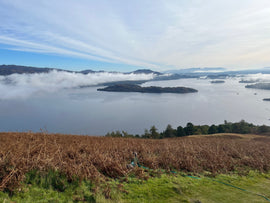As we know all too well at the gallery, Scotland's landscapes and diverse wildlife are a paradise for photographers. From the rugged peaks of Glencoe to the moors and coastlines of the Outer Hebrides, and from the majestic red deer to the elusive golden eagle, Scotland offers photographers endless opportunities to capture nature at its most raw and magnificent.
In this guide, we’ll take you through the essential camera equipment for capturing Scotland’s landscapes and wildlife, with Jack's real-world recommendations to guide you. Whether you’re planning your first trip or refining your kit, let’s get you prepared.

A Sturdy Camera Body — Your Reliable Foundation
Scotland’s weather is as famous as its scenery, unpredictable, dramatic, and often challenging. You’ll need a camera body that can handle everything from misty mornings on Skye to golden sunsets in Glen Etive.
Look for a camera with:
-
High resolution (ideal for detailed landscape shots)
-
Good low-light performance (sunrise and twilight are prime times)
-
Weather-sealing (a must for outdoor work in Scotland)
Recommended camera types:
-
Mirrorless (Full Frame or APS-C) — Lightweight and powerful (e.g., Sony, Canon R series, Nikon Z)
-
DSLRs — Still excellent, rugged, and with a wide lens selection
Jack's Essential:
"As of 2023, I use a full frame digital interchangeable lens camera: the Sony A7RIV. In combo with other digital equipment, I'm able to use it remotely too with my aerial drone equipment (look out for a future drone-specific equipment blog)."
Pro Tip:
Don’t get too caught up in brand wars. Focus on a body that feels comfortable in your hands and suits your shooting style. And remember, technique trumps specs every time.

Quality Lenses to Capture Scotland’s Soul
Lenses are where much of the magic happens. Scotland demands versatility: wide for those sweeping vistas, long for distant wildlife, and sometimes specialist lenses for unique compositions.
Essential Lens Types:
-
Wide-Angle (16-35mm, 24mm primes)
Perfect for capturing the vastness of landscapes like Rannoch Moor or the Cuillin Hills. -
Telephoto (100-400mm, 150-600mm)
Essential for wildlife, think red deer in the Cairngorms, or puffins on the Treshnish Isles. -
Prime Lenses (35mm, 50mm, 85mm)
Crisp, clear shots of people, details, or environmental portraits. -
Tilt-Shift Lens
Ideal for controlling distortion in architectural shots or refined landscape work.
Jack's Essential:
"I use a wide variety of lenses, the most important being a Tilt-Shift Lens."
Why Tilt-Shift?
-
Reduces distortion, particularly useful when shooting wide vistas or architecture like Eilean Donan Castle.
-
Adjusts the plane of focus and depth of field while keeping lines straight.
Jack's Technique Tip:
"When taking landscape images while it’s tempting to use a wide angle lens I actually will often try and get as far back as possible and use as narrow an angle lens as I can get away with so parts of the image don’t just appear so distant in the final image."
Pro Tip:
If you’re hiking long distances, plan your lenses carefully, weight adds up fast. A versatile zoom might beat carrying multiple heavy primes on a long trek through Glen Nevis.

Rain Cover — Prepare for the Highlands’ Wet Mood Swings
Let’s face it: rain and mist are part of Scotland’s charm. But they’re less charming when they’re soaking your camera gear.
Protection Essentials:
-
Camera rain cover (optional)
-
Quick-dry microfiber cloths
-
Lens hoods (good for rain and flare)
-
Dry bags for your backpack
Jack's advice:
"I don’t use a rain cover for the camera. They get in the way and not much use in the wind. I would hide it under my jacket if I’m worried and unlikely the camera is out when it’s chucking it down anyway. Be sure the camera is kept from any torrential rain that could get in your backpack when hiking."
Pro Tip:
Always have a small towel and silica gel packs in your bag. Humidity and rain can sneak into your gear, especially after long shoots.
Extra Batteries and Memory Cards — Don’t Get Stranded in the Highlands
Scotland’s best photo spots are often far from the nearest plug socket. Running out of battery (or memory) halfway through a golden sunset shoot is a heartbreak you don’t want.
Checklist:
-
At least 2-3 extra batteries (cold weather drains them faster)
-
High-capacity memory cards (64GB, 128GB or more)
-
Fast write speeds for burst shooting and 4K video
-
Reliable brands only — avoid fakes
Jack's Essential:
"Invest in something from a reliable brand such as Sandisk or Lexar. And from a reputable camera shop because there’s lots of fakes out there. A high-speed card is important if you are taking a burst of images as otherwise the camera has to take time to transfer the data over before it can take the next picture. Or if you're recording hi-resolution HD or 4K footage."
Pro Tip:
Backup your photos daily on the road, to a portable SSD or cloud storage if possible. Don’t rely on a single memory card for your whole trip.

Tripod — Your Best Ally for Stable, Striking Shots
A sturdy tripod is non-negotiable if you want tack-sharp landscapes or silky long exposures of Scotland's famous waterfalls.
Features to look for:
-
Lightweight (carbon fiber if you can afford it)
-
Sturdy in wind (Scotland can be breezy)
-
Quick setup (for capturing fleeting light)
Jack's Essential:
"I currently use a beaten-up old Manfrotto tripod that’s probably 20-30 years old. It’s aluminium but you can get lighter ones these days made from carbon fibre if you want to invest in a good piece of kit."
Pro Tip:
Learn to use your tripod well, balance it properly, weigh it down in wind, and make sure your settings match your subject (slow shutter speeds for water, faster for wildlife).

Bonus Accessories to Enhance Your Scottish Shoots
Want to go beyond the basics? These accessories can help refine your results:
-
Polarizing Filters
Reduce glare, deepen skies, and make greens pop, especially after rain. -
ND Filters
Create those dreamy, long-exposure water shots at Fairy Pools or Plodda Falls. -
Lens Cleaning Kit
Keep mist and sea spray from ruining your shots. -
Dry Bags & Padded Inserts
Protect your gear during hikes or boat trips. -
Lightweight Drone
For aerial views, Jack’s future blog will cover this in detail!
And Jack's Top Advice — Gear is Only Half the Story
Let’s return to where we started: gear helps, but skill is what makes you a great photographer.
Jack's Wisdom:
"I love new gear as much as anyone else, but it’s likely that’s not even close to the biggest limiting factor for any of us with our photography. So much comes down to your techniques and theory of photography. It’s important to note this as camera manufacturers spend a lot of money trying to convince us otherwise!"
Build your real strengths:
-
Learn composition — leading lines, rule of thirds, framing
-
Understand light — golden hours, mist, backlighting
-
Practice patience — wildlife and weather both reward those who wait
-
Know your subjects — from the habits of otters to the history of standing stones

Scottish Photography FAQs
Which lens is recommended for photographing wildlife in Scotland?
A telephoto lens is recommended, providing the reach and magnification needed to capture detailed shots of animals from a safe distance without disturbing them.
Is a weather-sealed camera recommended for photographing in Scotland's variable weather conditions?
Yes, a weather-sealed camera is recommended, providing added protection against moisture, dust, and cold temperatures while shooting outdoors.
Are there specific camera settings recommended for photographing Scottish landscapes?
Recommended settings include using a low ISO for optimal image quality, a narrow aperture (high f-stop) for maximum depth of field, and a tripod for stability, especially in low light conditions.
Do I need a tripod for photographing Scottish waterfalls?
Yes, to capture smooth, flowing water with long exposures, a tripod is essential for stability and sharpness.
Find similar articles
Applecross PhotographyBen Nevis PhotographyJack Marris PhotographyMountain PhotographyNature PhotographyNature Photography TipsPanoramic PhotographyPhotography EnthusiastsPhotography GuidePhotography TipsRAW PhotographyScottish Landscape PhotographyScottish Weather PreparednessWide-Angle PhotographyWildlife Photography


